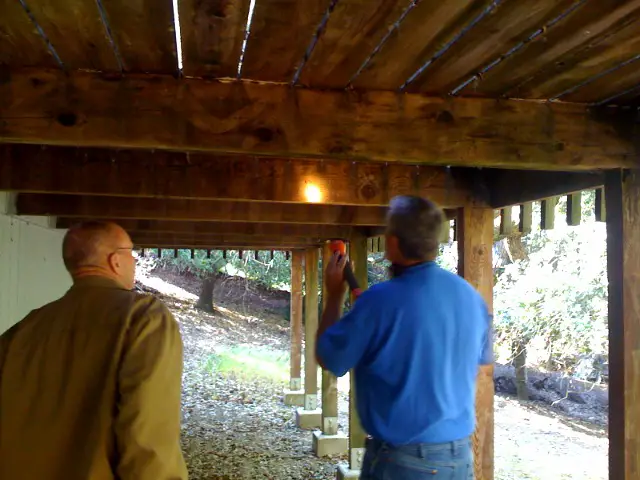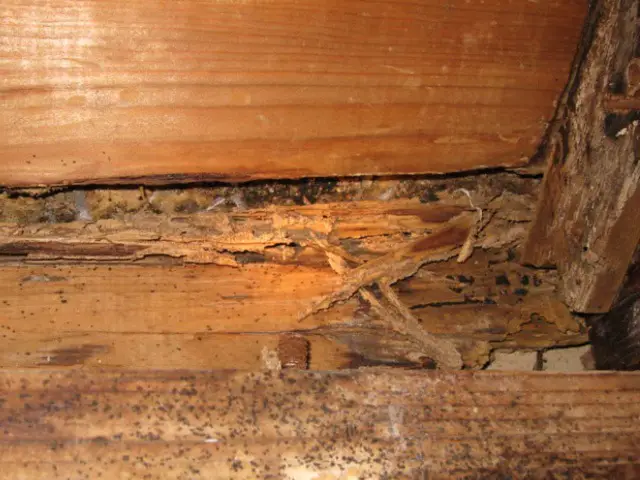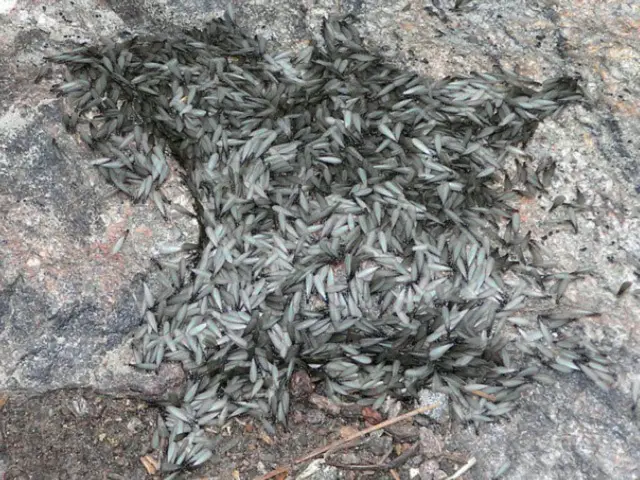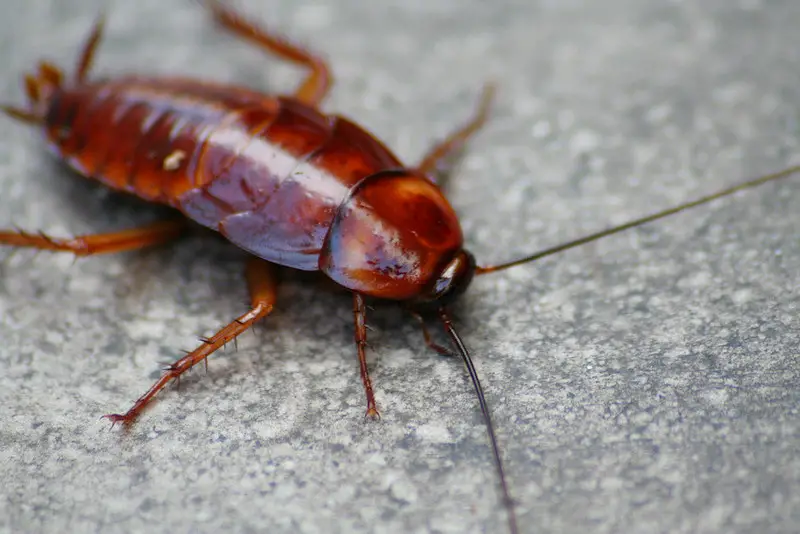Termites are very difficult pests to remove. Many homeowners prefer to get rid of termites without tenting. If you home is infested with termites, you might be thinking: “Is tenting always necessary for termites?”
You need a thorough termite inspection to find these harmful pests in your home. When they infest your home, they can cause damage and make it uninhabitable. One way to get rid of termites is by tenting. But the question is: “Can you get rid of termites without tenting?”
You can get rid of termites without tenting. While fumigation or tenting is sometimes the only feasible option, you might be able to get rid of termites with heat, electro-gun, or microwave.
Can you get rid of termites without tenting?
You can get rid of termites without tenting. Unfortunately, tenting is often the only option to eliminate termites, but there are times when you can control termites with microwave, heat, or electro-gun termite treatment.
Related posts:
- How To Prevent Termites In Florida?
- How To Prevent Termites In California?
- How To Prevent Termites In New York?
- How To Prevent Termites In Michigan?
- How To Prevent Termites In Pennsylvania?
- What Are Common Termites In Florida?
- How To Prevent Termites In Illinois?
- How To Prevent Termites In Ohio?
Can you get rid of termites without tenting your house?
If the termite infestation is localized, you can get rid of termites without tenting your house. You can treat localized termite infestations with heat, microwave and electro-gun termite treatment.
Do you have to tent to get rid of termites?
You don’t have to tent to get rid of termites.
Is tenting the only way to get rid of termites?
Tenting isn’t the only way to get rid of termites. Although tenting is an effective termite control method, it isn’t always required.
Instead of tenting, you can control termites with the following methods:
- Termite baits
- Orange oil treatment
- Boric acid treatment
- Termite sprays
- Spot wood treatment
- Liquid nitrogen treatment
How long does it take to get rid of termites in your house?
It only takes about 4-5 days to get rid of termites in your house. With termite sprays, you can get rid of termites within a few days. Once you have sprayed for termites, the termites will start dying within 24 hours. Termite baits take longer. The baits are effective in killing the queen. Although it’s slower than termite sprays, once the termites take the bait to the queen, the poison will kill the termite queen.
How to get rid of termites naturally?
Keep your home clean, and patios swept to prevent bugs from entering your living space. Get rid of any standing water on the property, as this is termites‘ favorite spot to look for food and shelter. Termites are destructive insects that can cause a tremendous amount of damage to your home or property. The good news is that there’s more than one way to get rid of termites naturally – and some methods are more effective than others.
Termites are a huge problem in the United States. They cost homeowners billions of dollars every year. One of the most complicated things about termites is that many treatments involve harsh chemicals that can be dangerous to people and pets.
Termites are pesky. They eat wood until it is reduced to ash. Boric Acid is a great start if you’re looking for effective techniques to get rid of termites naturally. Boric acid is a natural pesticide that prevents the termite from being able to extract nutrients no matter how much they eat. Therefore, the acid will eventually lead the termite to die. The acids come in powder or solution form, but they are best used outside due to their respiratory hazards.
Crushed garlic can get rid of pesky termites naturally while killing other insects too. Remember to place garlic in cracks and gaps in the framing.
To rid your home of termites, start by filling a quart jar with warm water and salt. Mix them together thoroughly until you achieve a nice, even mixture. If you plan to spray the entire house, use as much salt as you like. Next, examine your home for areas where exterior infestation could be entering or occurring. Then spray those areas thoroughly with the salty water mixture and apply it to any other wall voids or stressed areas as preventative measures. This method will kill most of the
To rid your home of termites, another option is to combine the juice of two lemons with a half cup of white vinegar. Pour this mixture into a spray bottle, and you’re on your way to doing some deep cleaning. First, spray it into mud holes that are entrance or onto mounds that you see. If done correctly, the concoction will sink deep into crevasses and grooves to kill termites. Just keep repeating these steps until they are no longer successful.
There are a few organic ways to rid your home of pesky termites. One is to sprinkle cayenne pepper around the area where you have seen them before and do this until they show up again or all disappear. Another option is creating a mixture to apply by blending vegetable oil with the cayenne pepper and spreading it around the infested area. This should be done for about four-five days, then checked on later.
Diatomaceous Earth, which consists of fossilized algae, is the perfect solution for those looking to rid their house and property of termites.
Rid your house of termites with the use of bait systems that are created using natural means. There are many types of bait you can create, but be sure to choose ones that are not dangerous to pets or children. Some options for making bait systems are cardboard, logs, or fodder seeds. The best type of bait system will vary depending on what you observe your particular termite activity to be.
Related posts:
- How To Prevent Termites In Texas?
- What Does A Termite Nest Look Like?
- How To Prevent Termites In Georgia?
- What Are The Early Signs Of Termite Damage?
- How To Prevent Termites In North Carolina?
- Is termite inspection required for an FHA loan?
- Is termite inspection required for a VA loan?
Think it’s too late to get rid of termites? Nematodes are not really related to true worms and are so tiny. You can’t see them with the naked eye. These types of worms can fight against a lot of pest species, including termites. Nematodes attack and kill their prey by injecting deadly bacteria or entering the host, parasitizing and then feeding on it. The benefit of these worms is that they are not destructive to wood and are not dangerous for
This will get rid of termites while also encompassing other pests that are lurking in the ground. The mixture blends worms with water, then sprays it into an infected area. The nematodes go into the wood and ensure that your house is insect-free. Just one spray a day should be enough for this treatment.
Other routes to get rid of termites might include proper research, different kinds of nematodes, etc.
You can now rid your home of pesky termites by following this recipe. Combine 5 ml nim oil, 2 ml liquid soap and 1-liter water, and use as needed.
Orange oil can get rid of termite infestations with little damage to humans or pets. D-limonene, which comes from orange rinds, emits no toxins and is effective early in termite infestation. Orange oil may have to be applied multiple times in several places for it to have an effect.
The US has always faced an invisible enemy that lurks in cracks and walls and can do a colossal amount of damage in very little time! These little attackers are nothing else but tiny termites. Their significant size gives a mistaken view about the amount of havoc they can inflict on any house or property. Their unified attacks are more than a match for ordinary mortals. Pest control services are an absolute must if you find yourself facing a termite problem.
Some deadly facts about termites:
- Termites shared the earth with dinosaurs. They have been around for that long. Dinosaurs disappeared; termites did not.
- Termites have wings that they shed after they decide to build a nest.
- Termites usually congregate in hundreds and thousands, even in millions. Their colonies raise the young together.
- If your group all the termites on earth, you will find they weigh more than all the human beings put together.
- The US faces an expenditure of billion dollars each year from termite damage.
- Termites feed all day, all night – all year round! They feed, and they feed.
- They lay one egg every 15 seconds and have a life span of 15 years.
- They can reduce an entire house to rubble when given free rein for two to three years.
- In one instance, a termite mound was built to 42 feet in height!
Termites recycle wood to return it into the soil for completing the food chain. They are fine as long as they live in the deep woods and work on decaying tree stumps. The problem occurs when they invade homes.
Termites love damp and moist wood to feed on. There are currently about 2700 species of termites known on earth. Every US state, except Alaska, has termites. Out of these species, the subterranean termites are the most deadly. They live under the soil and possess the capacity to build a tunnel right to house foundations. Finally, they will destroy the foundation, leaving only the shell. Remember that wood under the soil tends to be damp and moist- ideal for termites!
Pest control services help to identify termite infestations, their number and location. Then the firm will suggest the time, cost and duration of performing the pest control operation in your house. It often becomes difficult to identify the nests as they might be hidden in the walls and the ceiling. Only pest control professionals will know what to do and how to do it. If you suspect a termite infestation, it is time to grab the phone book and call a reputed firm.
Are termites pests?
While termites are considered pests, you can’t exterminate them like other pests. This is the primary reason that there is a huge difference between pest control and termite control. Pest control eliminates any living organism considered a nuisance or “pest” in a residential or commercial area. Termite control, on the other hand, refers mainly to wood-destroying pests. But what is the difference between general pest control and termite control?
General pest control is applied topically, effectively treating crawling pests like roaches, spiders, ants, etc. However, subterranean termites live deep underground. Some termites live inside mud tubes that they build to travel between their food source and nests. The food source can be and often is someone’s home.
Traditional topical pest control treatments don’t penetrate these deep underground lairs; they are ineffective at treating and eliminating termites. Instead, termites require professional termite control products applied in the ground around your home’s foundation that destroy the entire termite colony rather than just killing a few.
Termites are a group of insects that mainly feed on dead plant materials to digest cellulose. The most destructive wooden pest globally, subterranean termites build their colonies in the soil and generally work their way above ground to reach wood or some other cellulose source. In search of food, subterranean termites will forage into homes underground, right up to the highest point of the roof thrust. As a result, termite damage can become significant on door frames, kitchen cabinets, staircase, and wooden and laminate flooring as time goes on.
What types of termites are there?
There are two main categories of termites that can infest your home or property. Subterranean Termites are the most destructive species. The hard, saw-like jaws of these termites are able to bite off small fragments of wood, possibly leading to the collapse of an entire building.
Drywood termites have smaller colonies and a slower rate of feeding, so the damage they cause often goes unnoticed by homeowners. Because the behavior and effective treatment options differ between the two categories, it is important to be able to distinguish between subterranean and dry wood termites.
Identifying the Termites: Subterranean
- Need contact with the soil
- Live underground
- Build tunnels called mud tubes
- Travel to structures through the ground
- Require a lot of moisture to survive
- Most common in the southern parts of the United States.
Formosan termites
Formosan termites a species of subterranean termites, are most common in parts of Louisiana, Texas, and Florida.
- Most destructive species
- Fast-paced feeding
- Jaws allow for more destruction of the wood
- More difficult to control because they can travel through the ground to a structure, making the nest harder to find.
Drywood Termites
- Live inside the wood they infest
- Do not require soil contact
- Do not build mud tubes
- Can arrive by air or through moveable wooden objects, such as furniture
- Require much less moisture than subterranean termites
- Most common near the Gulf Coast and Southern California
- Not as economically dangerous as subterranean termites
- Smaller colonies
- Slower rate of feeding
- Easier to control because the colony is limited to one piece of wood, although it should not be ignored.
Termite Behavior: What to Look For
- Swarming insects around your home’s foundation
- Piles of mud near the foundation
- Tunnels- hanging tunnels are even possible if you have a bad infestation
- Pieces of wood that produce a hollow sound when hit with a hammer
- Small wood debris around windows and doors
- Excessive creaking in floorboards
Termite treatment and control
Subterranean termites can be treated using three different methods:
- Liquid repellent termiticide treatment
- Liquid non-repellent termiticide treatment
- Termite bait systems
Liquid repellant treatments discourage termites from attacking the actual structure. Products such as Demon TC, Prelude, and Talstar are effective. Liquid non-repellant treatments don’t discourage termites from infesting the wood. Its strategy is to allow the termites to spread the poison throughout their own colony. These repellants allow the termites to live up to 90 days after exposure so that when they go back, they poison the entire colony.
This can cause rapid termite decline that can last for a number of years, although it may not completely eradicate the termite colony. Phantom, Premise, and Termidor are reliable products. Termite bait systems are more consumer-friendly because they use fewer chemicals than the other methods.
The termites feed on the bait and take it back to the colony, killing the most termites possible. These baiting systems also have a mass effect that can decrease the population and kill the entire colony. Reliable brands include FirstLine, Advance, and HexPro.
Drywood termites are treated using either:
- Structural fumigation
- Localized or spot wood treatment
Structural fumigation is used for extensive infestations of dry wood termites. Fumigation involves introducing Vikane gas or Bromo-gas to the infested wood. Fumigations are effective because it completely replaces all the oxygen with the deadly poison when the gas is introduced. The termites then breathe the gas, killing them almost immediately. Licensed fumigators must perform fumigation because the gas is quite dangerous, resulting in nearly 100% elimination of all insects and mammals.
Localized or spot wood treatment is used for limited infestations. When the termite colony can be located and is limited to a small area or piece of wood, a localized wood treatment, foam, or dust can be very effective. Holes are drilled into the infested wood, and then the insecticide is inserted and dispersed throughout. Aerosols such as Termidor Foam, Termidor Dry, Premise Foam, and Alpine Foam are recommended. Foams like Timbor and TriDie are effective. TriDies silica gel is a dust that works well.




